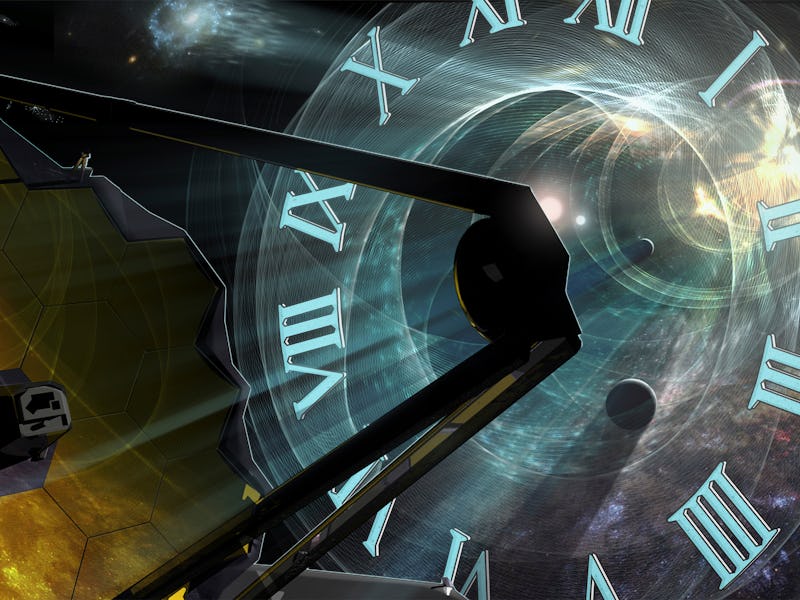Dark matter: How the Webb telescope can help solve a cosmic mystery
It will have an important role to play.

Now that the James Webb Space Telescope (JWST) is safely in space and nearly fully deployed, it’s worth taking a look at some of the cosmic mysteries astronomers hope to unlock with NASA’s new flagship observatory. Among a list of high-priority targets, it will interrogate two of the most enigmatic puzzles facing astronomy and cosmology today.
JWST is optimized to look far out into the cosmos and deep into the past to image the very first stars and galaxies. It will also help better characterize exoplanets and search for evidence of life in the atmosphere of worlds around other stars. And it may well provide insights into some of the most esoteric questions in cosmology, helping to better characterize — really, to characterize at all — the nature of dark matter and dark energy.
And while digging deep into these mysterious entities that together make up around 95 percent of the stuff in the universe is more the purview of the upcoming Nancy Grace Roman Space Telescope, JWST could still have an important, synergistic role to play with other dark matter and energy hunters.
What are dark matter and dark energy?
Dark matter and dark energy are cosmic forces inferred by their influence on the universe.
The discovery in 1998 that the universe is not only expanding but accelerating in its expansion, implied some unknown force or energy that was driving that expansion, and that as-yet-unknown quantity has been dubbed dark energy.
Similarly, dark matter is inferred by its observable effects on galaxies, which behave as if they are more massive than the visible matter and energy in them would dictate. Until the discovery of the accelerating expansion of the universe, astronomers thought the gravitational effects of dark matter’s added mass would cause the universe’s expansion to slow down.
Both dark matter and dark energy are dark because they don’t appear to interact with light or normal matter, but they also appear to outnumber all that stuff we can see out there. Scientists estimate 25 percent of the universe consists of dark matter, and some 75 percent of dark energy, leaving just 5 percent for everything else we see.
How will JWST “see” dark matter and energy?
JWST is the most powerful space telescope ever launched, with a six-and-half-meter diameter primary mirror and the ability to focus on single objects very, very far away.
When it comes to dark matter, this should allow JWST to make use of gravitational lensing — the way the mass of a galaxy bends light from galaxies behind it as the photons pass by the foreground galaxy. By imaging distant galaxies behind closer galaxies, JWST will enable scientists to measure the total mass of the closer galaxies by how much they bend the light from the background galaxies. The difference in the predicted mass of those foreground galaxies and what JWST measures could be the mass of the hidden dark matter around the galaxy.
“Webb will be particularly well-suited for this type of measurement, because its very sharp images will allow very small disturbances to be measured,” reads a NASA FAQ on JWST and dark matter. And, “because it can see so deep into space, giving it access to many more background galaxies to measure disturbances caused by this gravitational lensing effect.”
Dark energy was first revealed based on the observations of distant supernovae and confirmed in 2003 with measurements of the cosmic microwave background, the afterglow of the Big Bang. Supernovae are “like lamp posts,” Space Telescope Science Institute astronomer Adam Riess tells Inverse. “They allow us to make measurements of the expansion rate of the universe.”
The cosmic microwave background.
Riess was one of the scientists who shared the 2011 Nobel Prize in physics for the discovery of dark energy, and he says JWST should allow more precise measurements of supernovae, allowing more precise measurements of the expansion of the universe, which in turn relates to dark energy.
What are the limitations on JWST’s dark matter and energy studies?
JWST is optimized as an infrared telescope for peering deep into the past and outer reaches of the cosmos, a narrow field of view instrument for looking at single objects very closely. That’s exactly the qualities you want for imaging the first stars in the universe and studying the atmosphere of distant worlds, but it’s not the best tool for studying dark matter and dark energy.
“Telescopes that are optimized to study dark energy try to observe a large fraction of the sky,” Riess says. “The way we learn about it and measure it is by adding up its consequences over a lot of space or a lot of volume.”
The upcoming Nancy Grace Roman Telescope, expected to launch in 2027, will by contrast sport a wild field of view capable of imaging wide swaths of sky, which is exactly what you need to measure the effects of mysterious forces on large structures or portions of the universe.
“It's sort of like saying, ‘Can I measure gravity using a grain of sand?’ Yeah, but you'd be better off using a cannonball,” Riess says.
JWST and Nancy Grace Roman could, however, work together once Roman is deployed. Roman may identify hundreds of distant supernovae, for instance, but JWST will be the one to make the most precise measurements of those distant lampposts possible.
“JWST might follow up a small number of them and look at them in more detail,” Riess says, “Basically stress test them and see if they're telling us the truth.”
This article was originally published on